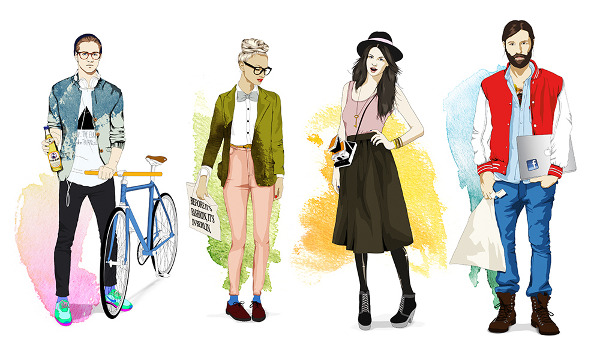By Nurul Hanani Hasmin
What really goes through your mind when you hear the word ‘Hipster’? Food truck? Flannel shirt? Beards? Â Coffee? Or perhaps skinny jeans? According to Urban Dictionary, ‘Hipsters’ are subculture of men or women typically in their 20’s and 30’s who follow the latest trend or fashion.
The term ‘hipster’ has become used rather frequently to identify anyone who does not appear mainstream and prefer more to stand out of the crowd. They try to set themselves apart from the culture as a whole, while remaining within the culture.
Hipster culture is a contemporary subculture. The imitation of hipster culture in youth across America, Europe, Asia and Australia has caused it to grow in size and popularity. Their desire to be welcomed into this group has led to its inclusion in pop music, art, fashion and even food.
The hipster subculture began in the 1940s and evolved overtime that leave us with the hipster of today. Hipsters in the 1940s did not believe in the traditional cycle of job, family life, and social life on the weekend and anything else that was done by the larger population. They prefer to isolate themselves from mainstream society. Instead they prefer to latch onto something that was artistic, or anything that is not embraced by the greater public.
The 1940s hipsters embraced jazz music. They primarily focused on enjoying the music and differentiating themselves with the upper class while creating bonds with those in the same class and similar background.
Modern hipsters on the other hand, rarely claim to be a part of the group. They love to deny the fact that they are hipsters. Have you ever met a hipster who is all like œMan, Im a hipster and I love being it! because I havent. No one ever identifies himself or herself as a hipster.
The images of the modern hipsters are much clearer than the hipsters from the 1940s that focuses on community building. This is because the modern subculture is more heavily focused on fashion and appearance. The use of irony is the key aspects to their fashion, music preferences and anything that is accessible to the public eye.
Skinny jeans and thick-rimmed glasses have become the symbol of the modern hipster. In fact, it is impossible for us to walk along the street these days without encountering somebody wearing a pair of black thick-rimmed glasses that werent even prescribed to them. Even the retros are cool again.
As we all know, the hipsters culture is becoming increasingly visible in Malaysian society. Hipsters usually hangout and gather in arty cafes musical festivals and at craft markets. Even though it sounds like a harmless trend so far, there are new research by the Youth United in Medicine (YUM), Â a non-profit organisation that conducts medical research, Â indicates that Malaysian hipsters are endangering themselves. They suggested that young Malaysians are not suited to a œhipster lifestyle and might lead to health damage.
A report by YUM found that skinny jeans, the main apparel for many hipsters, should not be worn in Malaysia. This is because, œSkinny jeans are not designated for Malaysian climate, said the YUM spokesperson, Dr. Pee Wee Lee. Wearing skinny jeans in hot and humid condition may cause skin infection to the wearers.
Another important part of hipster culture is the food. We can see even in Malaysia, many restaurants and café s are getting smart by combining hipster trends into their menus and designs.
Of course, hipster trends go way beyond thick framed glasses and skinny jeans. These trends, like food trucks and small plates, are easy for restaurants and cafes to incorporate. By focusing on hipster trends, restaurants and cafes can easily attract their customers. It is no secret that food trucks are hipster bait.***
